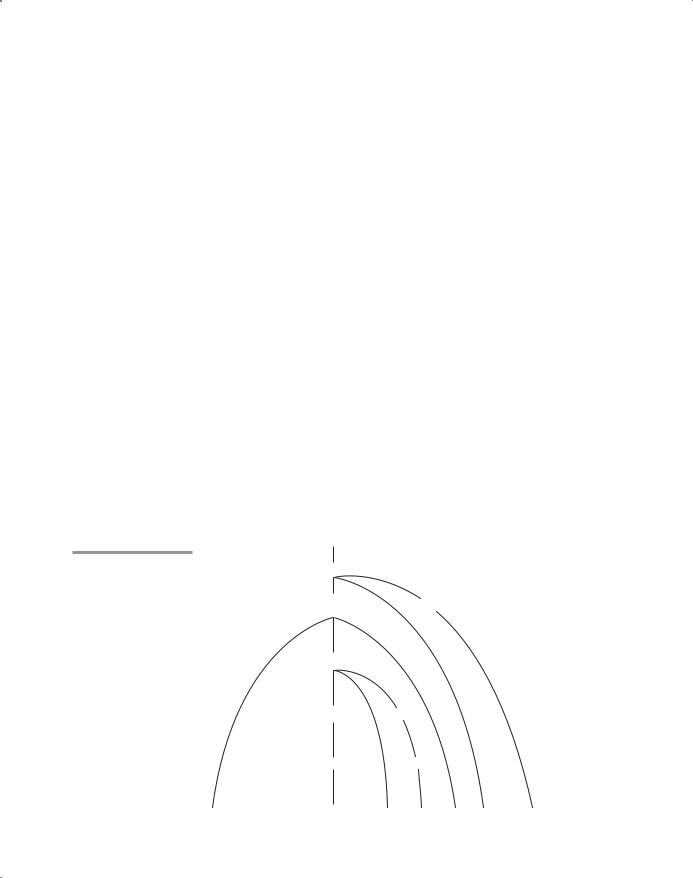
- •New to the Tenth Edition
- •Preface
- •Acknowledgments
- •About the Author
- •Contents
- •1.1 Reasons for Studying Concepts of Programming Languages
- •1.2 Programming Domains
- •1.3 Language Evaluation Criteria
- •1.4 Influences on Language Design
- •1.5 Language Categories
- •1.6 Language Design Trade-Offs
- •1.7 Implementation Methods
- •1.8 Programming Environments
- •Summary
- •Problem Set
- •2.1 Zuse’s Plankalkül
- •2.2 Pseudocodes
- •2.3 The IBM 704 and Fortran
- •2.4 Functional Programming: LISP
- •2.5 The First Step Toward Sophistication: ALGOL 60
- •2.6 Computerizing Business Records: COBOL
- •2.7 The Beginnings of Timesharing: BASIC
- •2.8 Everything for Everybody: PL/I
- •2.9 Two Early Dynamic Languages: APL and SNOBOL
- •2.10 The Beginnings of Data Abstraction: SIMULA 67
- •2.11 Orthogonal Design: ALGOL 68
- •2.12 Some Early Descendants of the ALGOLs
- •2.13 Programming Based on Logic: Prolog
- •2.14 History’s Largest Design Effort: Ada
- •2.15 Object-Oriented Programming: Smalltalk
- •2.16 Combining Imperative and Object-Oriented Features: C++
- •2.17 An Imperative-Based Object-Oriented Language: Java
- •2.18 Scripting Languages
- •2.19 The Flagship .NET Language: C#
- •2.20 Markup/Programming Hybrid Languages
- •Review Questions
- •Problem Set
- •Programming Exercises
- •3.1 Introduction
- •3.2 The General Problem of Describing Syntax
- •3.3 Formal Methods of Describing Syntax
- •3.4 Attribute Grammars
- •3.5 Describing the Meanings of Programs: Dynamic Semantics
- •Bibliographic Notes
- •Problem Set
- •4.1 Introduction
- •4.2 Lexical Analysis
- •4.3 The Parsing Problem
- •4.4 Recursive-Descent Parsing
- •4.5 Bottom-Up Parsing
- •Summary
- •Review Questions
- •Programming Exercises
- •5.1 Introduction
- •5.2 Names
- •5.3 Variables
- •5.4 The Concept of Binding
- •5.5 Scope
- •5.6 Scope and Lifetime
- •5.7 Referencing Environments
- •5.8 Named Constants
- •Review Questions
- •6.1 Introduction
- •6.2 Primitive Data Types
- •6.3 Character String Types
- •6.4 User-Defined Ordinal Types
- •6.5 Array Types
- •6.6 Associative Arrays
- •6.7 Record Types
- •6.8 Tuple Types
- •6.9 List Types
- •6.10 Union Types
- •6.11 Pointer and Reference Types
- •6.12 Type Checking
- •6.13 Strong Typing
- •6.14 Type Equivalence
- •6.15 Theory and Data Types
- •Bibliographic Notes
- •Programming Exercises
- •7.1 Introduction
- •7.2 Arithmetic Expressions
- •7.3 Overloaded Operators
- •7.4 Type Conversions
- •7.5 Relational and Boolean Expressions
- •7.6 Short-Circuit Evaluation
- •7.7 Assignment Statements
- •7.8 Mixed-Mode Assignment
- •Summary
- •Problem Set
- •Programming Exercises
- •8.1 Introduction
- •8.2 Selection Statements
- •8.3 Iterative Statements
- •8.4 Unconditional Branching
- •8.5 Guarded Commands
- •8.6 Conclusions
- •Programming Exercises
- •9.1 Introduction
- •9.2 Fundamentals of Subprograms
- •9.3 Design Issues for Subprograms
- •9.4 Local Referencing Environments
- •9.5 Parameter-Passing Methods
- •9.6 Parameters That Are Subprograms
- •9.7 Calling Subprograms Indirectly
- •9.8 Overloaded Subprograms
- •9.9 Generic Subprograms
- •9.10 Design Issues for Functions
- •9.11 User-Defined Overloaded Operators
- •9.12 Closures
- •9.13 Coroutines
- •Summary
- •Programming Exercises
- •10.1 The General Semantics of Calls and Returns
- •10.2 Implementing “Simple” Subprograms
- •10.3 Implementing Subprograms with Stack-Dynamic Local Variables
- •10.4 Nested Subprograms
- •10.5 Blocks
- •10.6 Implementing Dynamic Scoping
- •Problem Set
- •Programming Exercises
- •11.1 The Concept of Abstraction
- •11.2 Introduction to Data Abstraction
- •11.3 Design Issues for Abstract Data Types
- •11.4 Language Examples
- •11.5 Parameterized Abstract Data Types
- •11.6 Encapsulation Constructs
- •11.7 Naming Encapsulations
- •Summary
- •Review Questions
- •Programming Exercises
- •12.1 Introduction
- •12.2 Object-Oriented Programming
- •12.3 Design Issues for Object-Oriented Languages
- •12.4 Support for Object-Oriented Programming in Smalltalk
- •12.5 Support for Object-Oriented Programming in C++
- •12.6 Support for Object-Oriented Programming in Objective-C
- •12.7 Support for Object-Oriented Programming in Java
- •12.8 Support for Object-Oriented Programming in C#
- •12.9 Support for Object-Oriented Programming in Ada 95
- •12.10 Support for Object-Oriented Programming in Ruby
- •12.11 Implementation of Object-Oriented Constructs
- •Summary
- •Programming Exercises
- •13.1 Introduction
- •13.2 Introduction to Subprogram-Level Concurrency
- •13.3 Semaphores
- •13.4 Monitors
- •13.5 Message Passing
- •13.6 Ada Support for Concurrency
- •13.7 Java Threads
- •13.8 C# Threads
- •13.9 Concurrency in Functional Languages
- •13.10 Statement-Level Concurrency
- •Summary
- •Review Questions
- •Problem Set
- •14.1 Introduction to Exception Handling
- •14.2 Exception Handling in Ada
- •14.3 Exception Handling in C++
- •14.4 Exception Handling in Java
- •14.5 Introduction to Event Handling
- •14.6 Event Handling with Java
- •14.7 Event Handling in C#
- •Review Questions
- •Problem Set
- •15.1 Introduction
- •15.2 Mathematical Functions
- •15.3 Fundamentals of Functional Programming Languages
- •15.4 The First Functional Programming Language: LISP
- •15.5 An Introduction to Scheme
- •15.6 Common LISP
- •15.8 Haskell
- •15.10 Support for Functional Programming in Primarily Imperative Languages
- •15.11 A Comparison of Functional and Imperative Languages
- •Review Questions
- •Problem Set
- •16.1 Introduction
- •16.2 A Brief Introduction to Predicate Calculus
- •16.3 Predicate Calculus and Proving Theorems
- •16.4 An Overview of Logic Programming
- •16.5 The Origins of Prolog
- •16.6 The Basic Elements of Prolog
- •16.7 Deficiencies of Prolog
- •16.8 Applications of Logic Programming
- •Review Questions
- •Programming Exercises
- •Bibliography
- •Index

4.4 Recursive-Descent Parsing |
181 |
the parsing process. Backing up the parser also requires that part of the parse tree being constructed (or its trace) must be dismantled and rebuilt. O(n3) algorithms are normally not useful for practical processes, such as syntax analysis for a compiler, because they are far too slow. In situations such as this, computer scientists often search for algorithms that are faster, though less general. Generality is traded for efficiency. In terms of parsing, faster algorithms have been found that work for only a subset of the set of all possible grammars. These algorithms are acceptable as long as the subset includes grammars that describe programming languages. (Actually, as discussed in Chapter 3, the whole class of context-free grammars is not adequate to describe all of the syntax of most programming languages.)
All algorithms used for the syntax analyzers of commercial compilers have complexity O(n), which means the time they take is linearly related to the length of the string to be parsed. This is vastly more efficient than O(n3) algorithms.
4.4 Recursive-Descent Parsing
This section introduces the recursive-descent top-down parser implementation process.
4.4.1The Recursive-Descent Parsing Process
A recursive-descent parser is so named because it consists of a collection of subprograms, many of which are recursive, and it produces a parse tree in top-down order. This recursion is a reflection of the nature of programming languages, which include several different kinds of nested structures. For example, statements are often nested in other statements. Also, parentheses in expressions must be properly nested. The syntax of these structures is naturally described with recursive grammar rules.
EBNF is ideally suited for recursive-descent parsers. Recall from Chapter 3 that the primary EBNF extensions are braces, which specify that what they enclose can appear zero or more times, and brackets, which specify that what they enclose can appear once or not at all. Note that in both cases, the enclosed symbols are optional. Consider the following examples:
<if_statement> → if <logic_expr> <statement> [else <statement>] <ident_list> → ident {, ident}
In the first rule, the else clause of an if statement is optional. In the second, an <ident_list> is an identifier, followed by zero or more repetitions of a comma and an identifier.
A recursive-descent parser has a subprogram for each nonterminal in its associated grammar. The responsibility of the subprogram associated with a particular nonterminal is as follows: When given an input string, it traces

182 |
Chapter 4 Lexical and Syntax Analysis |
out the parse tree that can be rooted at that nonterminal and whose leaves match the input string. In effect, a recursive-descent parsing subprogram is a parser for the language (set of strings) that is generated by its associated nonterminal.
Consider the following EBNF description of simple arithmetic expressions:
<expr> → <term> {(+ | -) <term>} <term> → <factor> {(* | /) <factor>} <factor> → id | int_constant | ( <expr> )
Recall from Chapter 3 that an EBNF grammar for arithmetic expressions, such as this one, does not force any associativity rule. Therefore, when using such a grammar as the basis for a compiler, one must take care to ensure that the code generation process, which is normally driven by syntax analysis, produces code that adheres to the associativity rules of the language. This can easily be done when recursive-descent parsing is used.
In the following recursive-descent function, expr, the lexical analyzer is the function that is implemented in Section 4.2. It gets the next lexeme and puts its token code in the global variable nextToken. The token codes are defined as named constants, as in Section 4.2.
A recursive-descent subprogram for a rule with a single RHS is relatively simple. For each terminal symbol in the RHS, that terminal symbol is compared with nextToken. If they do not match, it is a syntax error. If they match, the lexical analyzer is called to get the next input token. For each nonterminal, the parsing subprogram for that nonterminal is called.
The recursive-descent subprogram for the first rule in the previous example grammar, written in C, is
/* expr
Parses strings in the language generated by the rule: <expr> -> <term> {(+ | -) <term>}
*/
void expr() { printf("Enter <expr>\n");
/* Parse the first term */ term();
/* As long as the next token is + or -, get the next token and parse the next term */
while (nextToken == ADD_OP || nextToken == SUB_OP) {
lex();
term();
}
printf("Exit <expr>\n");
} /* End of function expr */

4.4 Recursive-Descent Parsing |
183 |
Notice that the expr function includes tracing output statements, which are included to produce the example output shown later in this section.
Recursive-descent parsing subprograms are written with the convention that each one leaves the next token of input in nextToken. So, whenever a parsing function begins, it assumes that nextToken has the code for the leftmost token of the input that has not yet been used in the parsing process.
The part of the language that the expr function parses consists of one or more terms, separated by either plus or minus operators. This is the language generated by the nonterminal <expr>. Therefore, first it calls the function that parses terms (term). Then it continues to call that function as long as it finds ADD_OP or SUB_OP tokens (which it passes over by calling lex). This recursive-descent function is simpler than most, because its associated rule has only one RHS. Furthermore, it does not include any code for syntax error detection or recovery, because there are no detectable errors associated with the grammar rule.
A recursive-descent parsing subprogram for a nonterminal whose rule has more than one RHS begins with code to determine which RHS is to be parsed. Each RHS is examined (at compiler construction time) to determine the set of terminal symbols that can appear at the beginning of sentences it can generate. By matching these sets against the next token of input, the parser can choose the correct RHS.
The parsing subprogram for <term> is similar to that for <expr>:
/* term
Parses strings in the language generated by the rule: <term> -> <factor> {(* | /) <factor>)
*/
void term() { printf("Enter <term>\n");
/* Parse the first factor */ factor();
/* As long as the next token is * or /, get the next token and parse the next factor */
while (nextToken == MULT_OP || nextToken == DIV_OP) {
lex();
factor();
}
printf("Exit <term>\n");
}/* End of function term */
The function for the <factor> nonterminal of our arithmetic expression grammar must choose between its two RHSs. It also includes error detection. In the function for <factor>, the reaction to detecting a syntax error is simply to call the error function. In a real parser, a diagnostic message must be

184 |
Chapter 4 Lexical and Syntax Analysis |
produced when an error is detected. Furthermore, parsers must recover from the error so that the parsing process can continue.
/* factor
Parses strings in the language generated by the rule: <factor> -> id | int_constant | ( <expr )
*/
void factor() { printf("Enter <factor>\n");
/* Determine which RHS */
if (nextToken == IDENT || nextToken == INT_LIT)
/* Get the next token */ lex();
/* If the RHS is ( <expr>), call lex to pass over the left parenthesis, call expr, and check for the right parenthesis */
else {
if (nextToken == LEFT_PAREN) { lex();
expr();
if (nextToken == RIGHT_PAREN) lex();
else
error();
}/* End of if (nextToken == ... */
/* It was not an id, an integer literal, or a left parenthesis */
else
error();
}/* End of else */
printf("Exit <factor>\n");;
}/* End of function factor */
Following is the trace of the parse of the example expression (sum + 47) / total, using the parsing functions expr, term, and factor, and the function lex from Section 4.2. Note that the parse begins by calling lex and the start symbol routine, in this case, expr.
Next token is: 25 Next lexeme is (
Enter <expr>
Enter <term>
Enter <factor>

Figure 4.2
Parse tree for (sum + 47) / total
4.4 Recursive-Descent Parsing |
185 |
Next token is: 11 Next lexeme is sum
Enter <expr>
Enter <term>
Enter <factor>
Next token is: 21 Next lexeme is +
Exit <factor>
Exit <term>
Next token is: 10 Next lexeme is 47
Enter <term>
Enter <factor>
Next token is: 26 Next lexeme is )
Exit <factor>
Exit <term>
Exit <expr>
Next token is: 24 Next lexeme is /
Exit <factor>
Next token is: 11 Next lexeme is total
Enter <factor>
Next token is: -1 Next lexeme is EOF
Exit <factor>
Exit <term>
Exit <expr>
The parse tree traced by the parser for the preceding expression is shown in Figure 4.2.
<expr>
<term>
<factor> <factor>
<expr>
<term> <term>
<factor> <factor>
( |
sum |
+ |
47 |
) |
/ |
total |

186 |
Chapter 4 Lexical and Syntax Analysis |
One more example grammar rule and parsing function should help solidify the reader’s understanding of recursive-descent parsing. Following is a grammatical description of the Java if statement:
<ifstmt> → if (<boolexpr>) <statement> [else <statement>]
The recursive-descent subprogram for this rule follows:
/* Function ifstmt
Parses strings in the language generated by the rule: <ifstmt> -> if (<boolexpr>) <statement>
[else <statement>]
*/
void ifstmt() {
/* Be sure the first token is 'if' */ if (nextToken != IF_CODE)
error(); else {
/* Call lex to get to the next token */ lex();
/* Check for the left parenthesis */ if (nextToken != LEFT_PAREN)
error(); else {
/* Call boolexpr to parse the Boolean expression */ boolexpr();
/* Check for the right parenthesis */ if (nextToken != RIGHT_PAREN)
error(); else {
/* Call statement to parse the then clause */ statement();
/* If an else is next, parse the else clause */ if (nextToken == ELSE_CODE) {
/* Call lex to get over the else */ lex();
statement();
} /* end of if (nextToken == ELSE_CODE ... */ } /* end of else of if (nextToken != RIGHT ... */
} /* end of else of if (nextToken != LEFT ... */ } /* end of else of if (nextToken != IF_CODE ... */
}/* end of ifstmt */
Notice that this function uses parser functions for statements and Boolean expressions, which are not given in this section.
The objective of these examples is to convince you that a recursive-descent parser can be easily written if an appropriate grammar is available for the

4.4 Recursive-Descent Parsing |
187 |
language. The characteristics of a grammar that allows a recursive-descent parser to be built are discussed in the following subsection.
4.4.2The LL Grammar Class
Before choosing to use recursive descent as a parsing strategy for a compiler or other program analysis tool, one must consider the limitations of the approach, in terms of grammar restrictions. This section discusses these restrictions and their possible solutions.
One simple grammar characteristic that causes a catastrophic problem for LL parsers is left recursion. For example, consider the following rule:
A → A + B
A recursive-descent parser subprogram for A immediately calls itself to parse the first symbol in its RHS. That activation of the A parser subprogram then immediately calls itself again, and again, and so forth. It is easy to see that this leads nowhere (except to a stack overflow).
The left recursion in the rule A → A + B is called direct left recursion, because it occurs in one rule. Direct left recursion can be eliminated from a grammar by the following process:
For each nonterminal, A,
1.Group the A-rules as A → A 1, c A m 1 2 c n where none of the >s begins with A
2.Replace the original A-rules with
A → 1A 2A c nA
A → 1A 2A mA
Note that specifies the empty string. A rule that has as its RHS is called an erasure rule, because its use in a derivation effectively erases its LHS from the sentential form.
Consider the following example grammar and the application of the above process:
E → E + T T
T → T * F F
F → (E) id
For the E-rules, we have 1 = + T and = T, so we replace the E-rules with
E→ T E
E → + T E
For the T-rules, we have 1 = * F and = F, so we replace the T-rules with
T→ F T
T → * F T

188 |
Chapter 4 Lexical and Syntax Analysis |
Because there is no left recursion in the F-rules, they remain the same, so the complete replacement grammar is
E→ T E
E → + T E
T → F T
T → * F T
F → (E) id
This grammar generates the same language as the original grammar but is not left recursive.
As was the case with the expression grammar written using EBNF in Section 4.4.1, this grammar does not specify left associativity of operators. However, it is relatively easy to design the code generation based on this grammar so that the addition and multiplication operators will have left associativity.
Indirect left recursion poses the same problem as direct left recursion. For example, suppose we have
A → B a A
B → A b
A recursive-descent parser for these rules would have the A subprogram immediately call the subprogram for B, which immediately calls the A subprogram. So, the problem is the same as for direct left recursion. The problem of left recursion is not confined to the recursive-descent approach to building topdown parsers. It is a problem for all top-down parsing algorithms. Fortunately, left recursion is not a problem for bottom-up parsing algorithms.
There is an algorithm to modify a given grammar to remove indirect left recursion (Aho et al., 2006), but it is not covered here. When writing a grammar for a programming language, one can usually avoid including left recursion, both direct and indirect.
Left recursion is not the only grammar trait that disallows top-down parsing. Another is whether the parser can always choose the correct RHS on the basis of the next token of input, using only the first token generated by the leftmost nonterminal in the current sentential form. There is a relatively simple test of a non–left recursive grammar that indicates whether this can be done, called the pairwise disjointness test. This test requires the ability to compute a set based on the RHSs of a given nonterminal symbol in a grammar. These sets, which are called FIRST, are defined as
FIRST( ) = {a => * a } (If => * , is in FIRST( ))
in which =>* means 0 or more derivation steps.
An algorithm to compute FIRST for any mixed string can be found in Aho et al. (2006). For our purposes, FIRST can usually be computed by inspection of the grammar.

4.4 Recursive-Descent Parsing |
189 |
The pairwise disjointness test is as follows:
For each nonterminal, A, in the grammar that has more than one RHS, for each pair of rules, A → i and A → j, it must be true that
FIRST( i) x FIRST( j) =
(The intersection of the two sets, FIRST( i) and FIRST( j), must be empty.)
In other words, if a nonterminal A has more than one RHS, the first terminal symbol that can be generated in a derivation for each of them must be unique to that RHS. Consider the following rules:
A → aB bAb Bb
B → cB d
The FIRST sets for the RHSs of the A-rules are {a}, {b}, and {c, d}, which are clearly disjoint. Therefore, these rules pass the pairwise disjointness test. What this means, in terms of a recursive-descent parser, is that the code of the subprogram for parsing the nonterminal A can choose which RHS it is dealing with by seeing only the first terminal symbol of input (token) that is generated by the nonterminal. Now consider the rules
A → aB BAb
B → aB b
The FIRST sets for the RHSs in the A-rules are {a} and {a, b}, which are clearly not disjoint. So, these rules fail the pairwise disjointness test. In terms of the parser, the subprogram for A could not determine which RHS was being parsed by looking at the next symbol of input, because if it were an a, it could be either RHS. This issue is of course more complex if one or more of the RHSs begin with nonterminals.
In many cases, a grammar that fails the pairwise disjointness test can be modified so that it will pass the test. For example, consider the rule
<variable> → identifier identifier [<expression>]
This states that a <variable> is either an identifier or an identifier followed by an expression in brackets (a subscript). These rules clearly do not pass the pairwise disjointness test, because both RHSs begin with the same terminal, identifier. This problem can be alleviated through a process called left factoring.
We now take an informal look at left factoring. Consider our rules for <variable>. Both RHSs begin with identifier. The parts that follow identifier in the two RHSs are (the empty string) and [<expression>]. The two rules can be replaced by the following two rules:
<variable> → identifier <new>
<new> → [<expression>]
